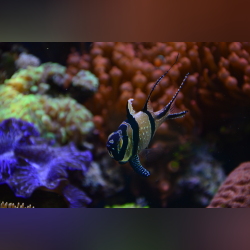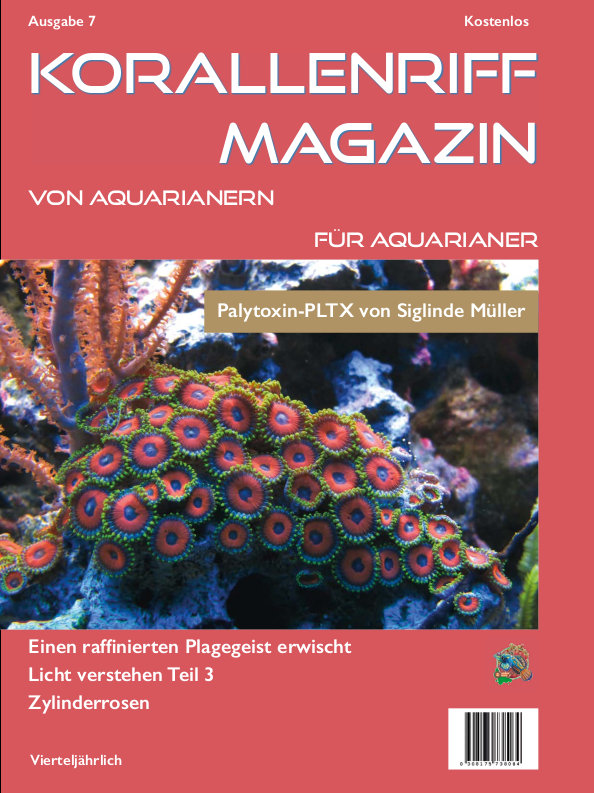Info
Stylophora pistillata has broad branches with blunt ends. The colonies become thicker and more massive as they grow. The maximum diameter of a colony is about 30 cm . Corallites are conical or hooded and are sunken below the general surface. Colonies may be cream, pink, bluish or green. Like most other stony corals, Stylophora lives in a symbiotic relationship with small algae (zooxanthellae) that provide nutrients to the corals.
Stylophora pistillata, usually referred to in the trade as Milka coral (color purple), is a reef-building species and prefers exposed habitats with strong water movement. Commensal coral crabs and the redhead coral goby (Paragobiodon echinocephalus) often live among the branches. Unfortunately, the coral can also be parasitized by harmful borer clams. In addition, Stylophora pistillata is susceptible to coral bleaching.
The care of small polyp stony corals was and is usually far more complex than that of most LPS corals and zooxanthellate soft corals due to the corals' requirements for water quality and lighting.
Therefore, only with the possibilities of skimming and live rock to produce a better water quality, as well as with better lighting and better calcium supply, the permanent keeping and reproduction came up.
Since keeping SPS corals became an achievable goal for many, zooxanthellate soft corals are hardly the main focus of most aquarists.
Identification of small-polyped and large-polyped stony corals is not always easy, despite really good works like Veron's book, Corals of the World, or the AIMS pages - especially since a definite identification should actually be made from the calcium skeleton.
One must also not forget that many animals in the aquarium do not look like they do in nature, and change their appearance due to current, light, as well as other influences.
However, it should be noted that the corals of the genus Stylophora are somewhat in the middle.
They are partly easier than many Montipora and Acropora species, although they should be given the same conditions.
Important parameters include:
Light:
All small polyp stony corals require very high light levels.
Therefore, they should tend to be located at the top of the tank with average lighting.
Heat/Cold:
Corals of the genus Stylophora will not tolerate water temperatures below 20 degrees or above 30 degrees for long periods of time.
Both cases they will acknowledge with bleaching.
Current:
They can tolerate quite a good current, though never have the pump outlet pointed directly at a coral.
Alternating, more turbulent flow conditions are best.
Water parameters:
Trace elements, (calcium 420-440 mg/L, magnesium 1100-1300 mg/L, KH below 8, strontium 8 mg/L). Water changes: at least 5% a week or 10% a month.
Water quality:
Permanently stable and clear water if possible, if necessary carbon filtration or ozonation is advisable to remove yellow substances.
The bucket comparison (white containers of the same size, in one freshly prepared water, in the other aquarium water) will quickly show you if your water in the aquarium is as clear as fresh water.
Acropora stony corals do not like to stand in a yellow broth.
Nitrate NO3:
Less than 5 mg/L.
Phosphate PO4:
Less than 0.1 mg/L better even in the range of 0.01 mg/L.
All the mentioned stony corals can be propagated by fragmentation.
Let's not forget the aspect of animal - and environmental protection that all coral breeders do by now.
The more offshoots, the less removals in nature.
Whereby also there in the years much has done.
So today corals from aquaculture are offered preferentially and sold as offspring.
Hint:
Strongly branched colonies and very variable in color.
Beside the color also the appearance is already very different.
Similarity with Stylophora danae and Stylophora subseriata.
Synonymised names:
Acropora digitata (Pallas, 1766) · unaccepted > superseded combination
Anthopora cucullata Gray, 1835 · unaccepted > junior subjective synonym
Madrepora (Porites) pistillata (Esper, 1792) · unaccepted > superseded combination
Madrepora digitata Pallas, 1766 · unaccepted > junior subjective synonym
Madrepora digitata spathulata (Ehrenberg, 1834) · unaccepted > junior subjective synonym
Madrepora pistillaris Esper, 1797 · unaccepted > junior subjective synonym
Madrepora pistillata Esper, 1792 · unaccepted > superseded combination (basionym)
Matrepora pistillata (Esper, 1792) · unaccepted > superseded combination
Millepora cellulata Forsskål, 1775 · unaccepted > junior subjective synonym
Pocillopora andreossyi Audouin, 1826 · unaccepted > junior subjective synonym
Porites digitata (Pallas, 1766) · unaccepted > junior subjective synonym
Porites digitata var. spathulata Ehrenberg, 1834 · unaccepted > junior subjective synonym
Porites digitate (Pallas, 1766) · unaccepted > junior subjective synonym (misspelling)
Porites elongata Lamarck, 1816 · unaccepted > junior subjective synonym
Porites pistillata (Esper, 1792) · unaccepted > superseded combination
Porites scabra Lamarck, 1816 · unaccepted > junior subjective synonym
Porites subdigitata Lamarck, 1816 · unaccepted > junior subjective synonym
Sideropora digitata (Pallas, 1766) · unaccepted > junior subjective synonym
Sideropora digitata de Blainville, 1830 · unaccepted > junior subjective synonym
Sideropora digitata var. coalescens Dana, 1846 · unaccepted > junior subjective synonym
Sideropora elongata (Lamarck, 1816) · unaccepted > junior subjective synonym
Sideropora mordax Dana, 1846 · unaccepted > junior subjective synonym
Sideropora palmata Blainville, 1830 · unaccepted > junior subjective synonym
Sideropora pistillata (Esper, 1792) · unaccepted > superseded combination
Sideropora subdigitata (Lamarck, 1816) · unaccepted > junior subjective synonym
Stylophora cellulosa Quelch, 1886 · unaccepted > junior subjective synonym
Stylophora dendritica Nemenzo, 1964 · unaccepted > junior subjective synonym
Stylophora digitata (Pallas, 1766) · unaccepted > junior subjective synonym
Stylophora digitata de Blainville, 1830 · unaccepted > junior subjective synonym
Stylophora digitata var. coalescens Dana, 1846 · unaccepted > junior subjective synonym
Stylophora elongata (Lamarck, 1816) · unaccepted > junior subjective synonym
Stylophora expanda Nemenzo, 1964 · unaccepted > junior subjective synonym
Stylophora mordax (Dana, 1846) · unaccepted > junior subjective synonym
Stylophora nana Nemenzo, 1964 · unaccepted > junior subjective synonym
Stylophora palmata (de Blainville, 1830) · unaccepted > junior subjective synonym
Stylophora pistillaris (Esper, 1797) · unaccepted > junior subjective synonym
Stylophora pistillata f. elongata Umbgrove, 1929 † · unaccepted > junior subjective synonym
Stylophora pistillata var. palmata (de Blainville, 1830) · unaccepted > junior subjective synonym
Stylophora prostrata Klunzinger, 1879 · unaccepted > junior subjective synonym
Stylophora septata Gardiner, 1898 · unaccepted > junior subjective synonym
Stylophora sinaitica Brüggemann, 1877 · unaccepted > junior subjective synonym
Stylophora stellata Verrill, 1864 · unaccepted > junior subjective synonym
Direct children (1):
Variety Stylophora pistillata var. palmata (de Blainville, 1830) accepted as Stylophora pistillata (Esper, 1792) (unaccepted > junior subjective synonym)







 SandraM
SandraM






























